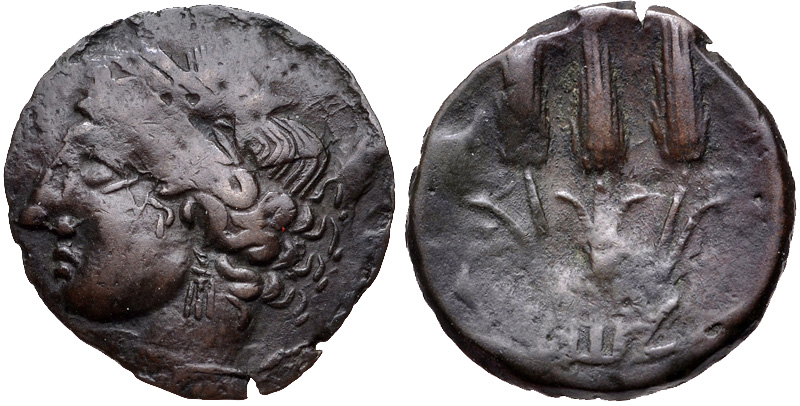SO 242 - Uncertain mint in Sardinia or Africa over uncertain mint
From SILVER
241 BCE - 238 BCE
Images
Overstriking coin

CNG_69.jpg [1]
Location/history
| Sale(s)Sale(s) ᵖ: | Classical Numismatic Group, EA 378, 13 July 2016, 69. | |
| Private collection(s)Private collection(s) ᵖ: | J.-P. Righetti collection, n°27 |
Overstriking coin
Description
| ObverseInscription or printing placed on the obverse.: | Head of Isis left. Border of dots. | ReverseInscription or printing placed on the reverse.: | Three grain ears. Border of dots. |
Mint and issuing power
| MintIdentifies the place of manufacture or issue of a numismatic object.: | Zeugitana (uncertain mint) | Ancient regionAncient region. | Zeugitana | Modern countryModern country: Tunisia | AuthorityIdentifies the issuing power. The authority can be "pretended" when the name or the portrait of X is on the coin but he/she was not the issuing power. It can also be "uncertain" when there is no mention of X on the coin but he/she was the issuing power according to the historical sources: | Carthaginian Empire, Lybian mercenaries (241-237 BCE) |
Chronology
| FromIdentifies the initial date in a range assigned in a numismatic context. 241 BCE toIdentifies the final date in a range assigned in a numismatic context.. 238 BCE | Hellenistic 323-30 BC |
Physical description
| MetalThe physical material (usually metal) from which an object is made.: Bronze |
WeightWeight of the numismatic object (in grams). in grams: 2.452.45 g <br />2,450 mg <br /> | DenominationTerm indicating the value of a numismatic object. Examples: tetradrachm, chalkous, denarius.: shekel |
AxisDescribes the directional relationship between the obverse and reverse of a numismatic object.: 66 mm <br />0.6 cm <br /> |
| DiameterDescribes diameter of an object (in mm).: 1919 mm <br />1.9 cm <br /> | |||
References
| Coin referenceReference of the Coin: | Kapossy 1993, n°27. | Coin series referenceReference to coin series study: | SNG Copenhagen North Africa1SNG Copenhagen North Africa, n°252, Alexandropoulos 20072Alexandropoulos 2007, n°70, Viola 20103Viola 2010, n°696e |
| Coin series web referenceCoin series web references: | |||
Overstruck type
Description
| ObverseInscription or printing placed on the obverse.: | Head of Tanit to left, wearing wreath of grain ears, triple-pendant earring and elaborate necklace | ReverseInscription or printing placed on the reverse.: | Head of horse to right, to right, punic letter ' (ayin) |
Mint and issuing power
| MintIdentifies the place of manufacture or issue of a numismatic object. ᵖ: | Carthage | Ancient regionAncient region. ᵖ | Zeugitana | Modern countryModern country: Tunisia | AuthorityIdentifies the authority in whose name (explicitly or implicitly) a numismatic object was issued. ᵖ: | Carthaginian Empire |
Chronology
| FromIdentifies the initial date in a range assigned in a numismatic context. 300 BCE toIdentifies the final date in a range assigned in a numismatic context.. 264 BCE | Hellenistic 323-30 BC |
Physical description
References
| Coin type referenceReference to coin series study ᵖ: | SNG Copenhagen North Africa1SNG Copenhagen North Africa, n° 151, Alexandropoulos 20072Alexandropoulos 2007, n° 57, HGC 24HGC 2, n° 1671 | ||
| Coin series web reference overstruckCoin series web references overstruck: | |||
Additional data
| Frequency of overstrikesFrequency of overstrikes: | frequent | Level of confidenceLevel of confidence of the identification: | strong |
| RemarksRemarks: | "Ces dernières monnaies sont celles des insurgés et ont donc très vraisemblablement été frappées en Afrique, même si elles sont en général surfrappées sur des monnaies d’origine principalement sarde no 58-59" (Alexandropoulos 2007) | ||
